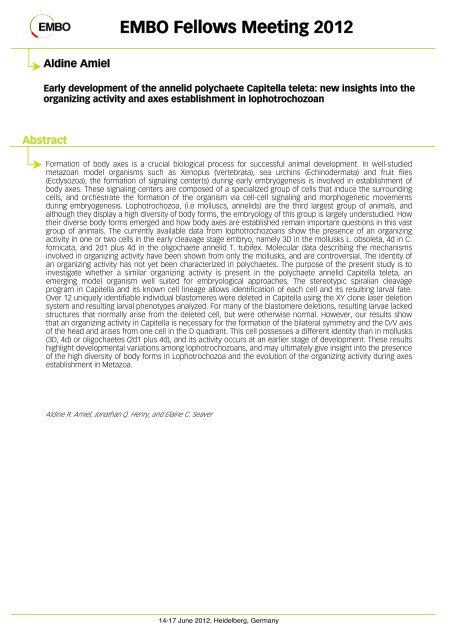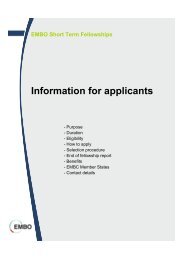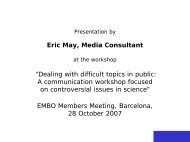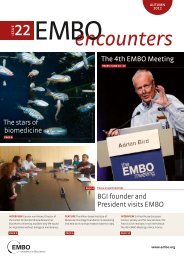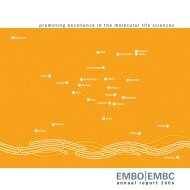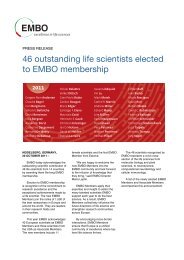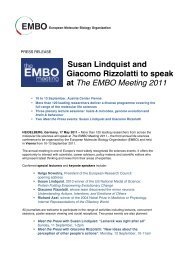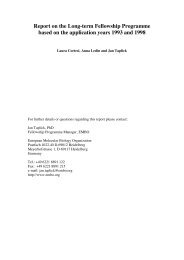EMBO Fellows Meeting 2012
EMBO Fellows Meeting 2012
EMBO Fellows Meeting 2012
Create successful ePaper yourself
Turn your PDF publications into a flip-book with our unique Google optimized e-Paper software.
Aldine Amiel<br />
<strong>EMBO</strong> <strong>Fellows</strong> <strong>Meeting</strong> <strong>2012</strong><br />
Early development of the annelid polychaete Capitella teleta: new insights into the<br />
organizing activity and axes establishment in lophotrochozoan<br />
Abstract<br />
Formation of body axes is a crucial biological process for successful animal development. In well-studied<br />
metazoan model organisms such as Xenopus (Vertebrata), sea urchins (Echinodermata) and fruit flies<br />
(Ecdysozoa), the formation of signaling center(s) during early embryogenesis is involved in establishment of<br />
body axes. These signaling centers are composed of a specialized group of cells that induce the surrounding<br />
cells, and orchestrate the formation of the organism via cell-cell signaling and morphogenetic movements<br />
during embryogenesis. Lophotrochozoa, (i.e molluscs, annelids) are the third largest group of animals, and<br />
although they display a high diversity of body forms, the embryology of this group is largely understudied. How<br />
their diverse body forms emerged and how body axes are established remain important questions in this vast<br />
group of animals. The currently available data from lophotrochozoans show the presence of an organizing<br />
activity in one or two cells in the early cleavage stage embryo, namely 3D in the mollusks L. obsoleta, 4d in C.<br />
fornicata, and 2d1 plus 4d in the oligochaete annelid T. tubifex. Molecular data describing the mechanisms<br />
involved in organizing activity have been shown from only the mollusks, and are controversial. The identity of<br />
an organizing activity has not yet been characterized in polychaetes. The purpose of the present study is to<br />
investigate whether a similar organizing activity is present in the polychaete annelid Capitella teleta, an<br />
emerging model organism well suited for embryological approaches. The stereotypic spiralian cleavage<br />
program in Capitella and its known cell lineage allows identification of each cell and its resulting larval fate.<br />
Over 12 uniquely identifiable individual blastomeres were deleted in Capitella using the XY clone laser deletion<br />
system and resulting larval phenotypes analyzed. For many of the blastomere deletions, resulting larvae lacked<br />
structures that normally arise from the deleted cell, but were otherwise normal. However, our results show<br />
that an organizing activity in Capitella is necessary for the formation of the bilateral symmetry and the D/V axis<br />
of the head and arises from one cell in the D quadrant. This cell possesses a different identity than in mollusks<br />
(3D, 4d) or oligochaetes (2d1 plus 4d), and its activity occurs at an earlier stage of development. These results<br />
highlight developmental variations among lophotrochozoans, and may ultimately give insight into the presence<br />
of the high diversity of body forms in Lophotrochozoa and the evolution of the organizing activity during axes<br />
establishment in Metazoa.<br />
Aldine R. Amiel, Jonathan Q. Henry, and Elaine C. Seaver<br />
14-17 June <strong>2012</strong>, Heidelberg, Germany


